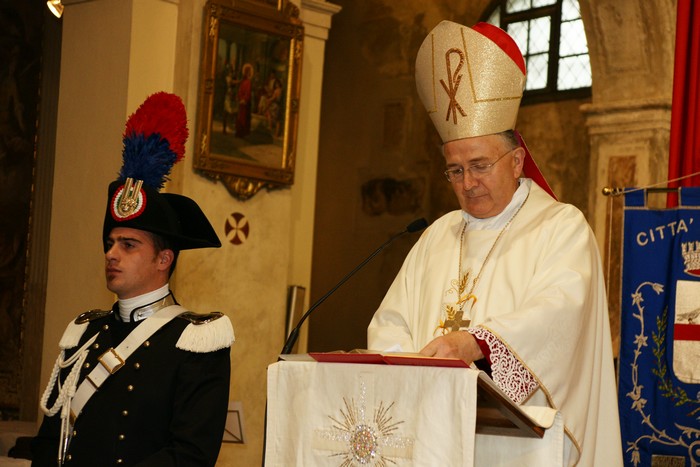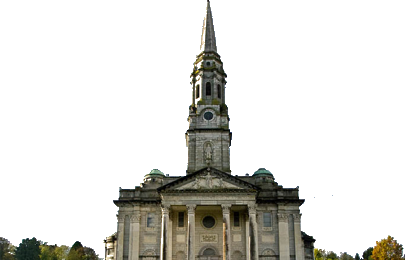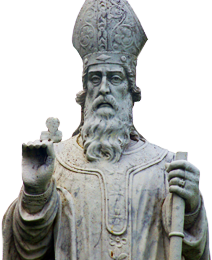Bishop Leo O’Reilly’s Homily
on the Feast of St Columban
Church of San Colombano, Al Lambro, Italy
21st November 2010
It’s a great honour for me as Bishop of the diocese of Kilmore in Ireland to preside at this Mass for the annual celebration of your patron saint, Saint Columban. I thank your bishop, Monsignor Merisi, for the warm welcome he has extended to us here in the diocese of Lodi. I thank your parish priest, Don Mario, for the invitation to celebrate this feast with you. It is truly a pleasure to be here and to share this occasion with you.
Kilmore is a small rural diocese near the border between the Republic of Ireland and Northern Ireland. The greater part of the diocese is in the Republic, with only two and a half parishes in the North. One of these parishes is situated along the shores of a beautiful lake, Lough Erne. During the monastic era in Ireland there were several monasteries on the island in this lake. Among them was the monastery on the island of Cleenish, which you are clearly familiar with, because I see a photograph of it beside the altar dedicated to the saint. It was in this monastery that St Columban started his religious life. Later he went to Bangor, near Belfast, where he spend many years under the guidance of St Comgall. We are blessed today in having a group of young people from St Columban’s Catholic Secondary School, Bangor here to take part in this celebration. They are accompanied by some of their teachers and their chaplain, Fr Joseph Rooney,
I know that you know more than I do about the history of St Columban: how he left Bangor with twelve companions to preach the gospel in Europe; how, after many years in France and Switzerland where he founded many monasteries, he came to Italy; finally, how he came to Bobbio, the most famous place associated with his name, the place where he spent the rest of his life and where he died in the year six hundred and fifteen.
I have to say that St Columban is honoured much more in the countries of his adoption than in the country of his origin. There are more than fifty churches, monasteries and shrines dedicated to him in Italy. There are many also in France, Germany, Switzerland and Austria. There are not so many in Ireland, though his memory is kept alive by the presence of the missionary Society of St Columban.
I cannot help admiring the initiative of this community in rediscovering the spiritual heritage of the saint and in renewing awareness of him and devotion to him. I applaud the efforts of your parish priest, Don Mario, his fellow workers, and above all, the commitment of the President of the Association of St Columban for Europe, Dr Mauro Steffinini. You have achieved this by networking, visits and pilgrimages, not only here in Italy but also so many other communities associated with the name of St Columban, both in Europe and in Ireland. In the name of Irish people everywhere I want to thank you for having revived the memory of the saint and devotion to him for a new millennium.
There are many lessons to be learned from the example and teaching of St Columban today. Perhaps the most important thing we can learn from the saint is the lesson of hope. Columban and his companions came to Europe at a time that was anything but favourable for Christianity. The barbarians had brought chaos and destruction to the continent. Society was on the brink of disintegration. Priests were demoralised, lay people without direction. These were the so-called ‘dark ages’. In this situation of despair St Columban and his companions set about preaching the gospel with great courage. Their example of humility, penance, modesty and charity reinforced their words and attracted many. People flocked to them in droves and through their preaching they found the joy and hope that comes from faith in Jesus Christ.
These days in Ireland we are experiencing our own dark ages. The scandals of abuse of children and young people by priests and religious in the past have damaged the faith of many. They have also damaged the morale of priests and the relationship between priests and bishops. The failures of bishops to deal with the abusing priests have seriously injured the trust of people in the Church. More recently we have had the scandals in the banking world and the collapse of the economy – the sudden death of the so-called ‘Celtic Tiger’. All of this has created an atmosphere of hopelessness, cynicism and despair.
This crisis in the faith and in society is not confined to Ireland. It seems to me that it is widespread in Europe today. The fathers of the European project, Schumann, De Gasperi, Monnet and others, were men of faith and this faith inspired their search for unity and peace on the continent. The European project still needs the light of faith to progress and to succeed today. In this context, St Columban, as a saint who travelled the whole continent and brought the faith to so many, is still relevant today. The light of his preaching and the example of his life can be a source of hope for a generation that has lost hope. I trust that one day soon he will be declared one of the co-patrons of Europe by the Church.
The Holy Father, when he was still Joseph Ratzinger, wrote about the important role of the saints:
The saints are like the stars on the horizon of our history, which continue to radiate light on the world in the midst of the darkness of this time, in the midst of its obscurity, so that we can see something of the light of God. And if, sometimes, we are tempted to doubt the goodness of God because of the vicissitudes of history, if we are assailed by doubts about man, because we don’t know whether he is good or maybe essentially bad and dangerous, if we doubt even the Church because of the controversies and the miseries that afflict it, then let us look at these men who were open to God, at these men in whom God has taken form. And from them we will again receive light.
Let us look today at St Columban, your patron, who was so open to God. From him we will receive once more light and faith and hope.
I would like to finish with a prayer of St Columban for light, so that we may experience this hope in our lives and be witnesses to the light of God to those around us:

Bishop Leo O’Reilly delivers his homily at the Church of San Colombano al Lambro, Italy




